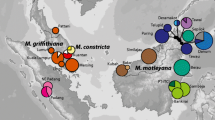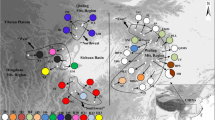Abstract
Macaranga (Euphorbiaceae) has received much ecological and evolutionary research attention as a genus that includes some of the most conspicuous pioneer trees of Southeast Asian tropical rainforests and because of its manifold associations with ants, including about 30 species that are obligate ant-plants (myrmecophytes). We used sequence data from three chloroplast DNA loci (ccmp5, ccmp6, atpB-rbcL) to assess phylogeographical patterns in species of Macaranga, section Pruinosae, sampled from various regions of Borneo and the Malay Peninsula. Forty-nine chloroplast DNA haplotypes (HT) were identified among 768 specimens from five species, Macaranga gigantea (N = 329; 23 HT), Macaranga pearsonii (N = 347; 21 HT), Macaranga puberula (N = 24; 4 HT), Macaranga hosei (N = 48; 6 HT), and Macaranga pruinosa (N = 20; 5 HT). Forty-one haplotypes were species-specific, whereas eight haplotypes were shared by two, three, or four species and occupied internal positions in a parsimony network. Population genetic parameters based on haplotype frequencies proved to be in a similar range in the non-myrmecophytic M. gigantea and in the ant-associated M. pearsonii, which have overlapping distributions in northern and eastern Borneo. A comparison of GST and NST values revealed a strong phylogeographic structure in both species, whereas colonization pathways suggested by the network topology were different. Both species exhibited similar levels of haplotypic diversity and moderate to high levels of population differentiation. There were no obvious indications for an influence of the symbiotic ant partners on the population structure of their host plants.



Similar content being viewed by others
References
Alvarez-Buylla ER, Garay AA (1994) Population genetic structure of Cecropia obtusifolia, a tropical pioneer tree species. Evolution 48:437–453
Bänfer G, Fiala B, Weising K (2004) AFLP analysis of phylogenetic relationships among myrmecophytic species of Macaranga (Euphorbiaceae) and their allies. Plant Syst Evol 248:213–231
Bänfer G, Moog U, Fiala B, Mohamed M, Weising K, Blattner FR (2006) A chloroplast genealogy of myrmecophytic Macaranga species (Euphorbiaceae) in southeast Asia reveals hybridization, vicariance and long distance dispersals. Mol Ecol 15:4409–4424
Berg CC, Rosselli PF, Davidson DW (2005) Cecropia. The New York Botanical Garden, Bronx
Blattner FR, Weising K, Bänfer G, Maschwitz U, Fiala B (2001) Molecular analysis of phylogenetic relationships among myrmecophytic Macaranga species (Euphorbiaceae). Mol Phyl Evol 19:331–344
Born C, Kjellberg F, Chevallier M-H, Vignes H, Dikangadissi J-T, Sanguié J, Wickings EJ, Hossaert-McKey M (2008) Colonization processes and the maintenance of genetic diversity: insights from a pioneer rainforest tree, Aucoumea klaineana. Proc R Soc Lond B 275:2171–2179
Brooks TM, Mittermeier RA, Mittermeier CG, da Fonseca GAB, Rylands AB, Komstant WR, Flick P, Pilgrim J, Oldfield S, Magin G, Hilton-Taylor C (2002) Habitat loss and extinction in the hotspots of biodiversity. Conserv Biol 16:909–923
Burban C, Petit RJ, Carcreff E, Jactel H (1999) Rangewide variation of the maritime pine bast scale Matsucoccus feytaudi Duc. (Homoptera: Matsucoccidae) in relation to the genetic structure of its host. Mol Ecol 8:1593–1602
Cannon CH, Manos PS (2003) Phylogeography of the Southeast Asian stone oaks (Lithocarpus). J Biogeogr 30:211–226
Cannon CH, Morley RJ, Bush ABG (2009) The current refugial rainforests of Sundaland are unrepresentative of their biogeographic past and highly vulnerable to disturbance. Proc Natl Acad Sci USA 106:11188–11193
Caron H, Dumas S, Marque G, Messier C, Bandou E, Petit RJ, Kremer A (2000) Spatial and temporal distribution of chloroplast DNA polymorphism in a tropical tree species. Mol Ecol 9:1089–1098
Cavers S, Navarro C, Lowe AJ (2003) Chloroplast DNA phylogeography reveals colonization history of a Neotropical tree, Cedrela odorata L., in Mesoamerica. Mol Ecol 12:1451–1460
Cavers S, Navarro C, Hopkins P, Ennos RA, Lowe AJ (2005) Regional and population-scale influences on genetic diversity partitioning within Costa Rican populations of the pioneer tree Vochysia ferruginea Mart. Silvae Genet 54:258–264
Clement M, Posada D, Crandall KA (2000) TCS: a computer program to estimate gene genealogies. Mol Ecol 9:1657–1660
Crandall KA, Templeton AR (1993) Empirical tests of some predictions from coalescent theory with applications to intraspecific phylogeny reconstruction. Genetics 134:959–969
Davies SJ (2001) Systematics of Macaranga sects Pachystemon and Pruinosae (Euphorbiaceae). Harv Pap Bot 6:371–448
Davies SJ, Lum SKY, Chan RKG, Wang LK (2001) Evolution of myrmecophytism in western Malesian Macaranga (Euphorbiaceae). Evolution 55:1542–1559
Dick CW, Heuertz M (2008) The complex biogeographic history of a widespread tropical tree species. Evolution 62:2760–2774
Doyle JJ, Morgante M, Tingey SV, Powell W (1998) Size homoplasy in chloroplast microsatellites of wild perennial relatives of soybean (Glycine subgenus Glycine). Mol Biol Evol 15:215–218
Dutech C, Maggia L, Joly HI (2000) Chloroplast diversity in Vouacapoua americana (Caesalpiniaceae), a neotropical forest tree. Mol Ecol 9:1427–14
Excoffier L, Laval G, Schneider S (2005) Arlequin ver. 3.0: an integrated software package for population genetics data analysis. Evol Bioinforma Online 1:47–50
FAO (2006) Global Forest Resource Assessment 2005. FAO, Rome
Fiala B, Maschwitz U, Tho YP, Helbig AJ (1989) Studies of a South East Asian ant–plant association: protection of Macaranga trees by Crematogaster borneensis. Oecologia 79:463–470
Fiala B, Jakob A, Maschwitz U, Linsenmair KE (1999) Diversity, evolutionary specialization and geographic distribution of a mutualistic ant–plant complex: Macaranga and Crematogaster in South East Asia. Biol J Linn Soc 66:305–331
Gathorne-Hardy FJ, Syaukani DRG, Eggleton P, Jones DT (2002) Quaternary rainforest refugia in Southeast Asia: using termites (Isoptera) as indicators. Biol J Linn Soc 75:453–466
Grivet D, Petit RJ (2002) Phylogeography of the common ivy (Hedera sp.) in Europe: genetic differentiation through space and time. Mol Ecol 11:1351–1362
Guicking D, Kröger-Kilian T, Weising K, Blattner FR (2008) Single nucleotide sequence analysis: a cost- and time-effective protocol for the analysis of microsatellite- and indel-rich chloroplast DNA regions. Mol Ecol Res 8:62–65
Hall R (2009) Southeast Asia’s changing palaeogeography. Blumea 54:158–161
Heil M, Fiala B, Maschwitz U, Linsenmair KE (2001) On the benefits of indirect defence: short- and long-term studies in antiherbivore protection via mutualistic ants. Oecologia 126:394–403
Jakob SS, Blattner FR (2006) A chloroplast genealogy of Hordeum (Poaceae): long-term persisting haplotypes, incomplete lineage sorting, regional extinction, and the consequences for phylogenetic inference. Mol Biol Evol 23:1602–1612
Kulju KKM, Sierra SEC, Draisma SGA, Samuel R, van Welzen PC (2007) Molecular phylogeny of Macaranga, Mallotus, and related genera. Am J Bot 94:1726–1743
Lewis T (1973) Thrips: their biology, ecology and economic importance. Academic, New York
Lewis T (1997) Flight and dispersal. In: Lewis T (ed) Thrips as crop pests. CAB International, Oxon, pp 175–196
Litrico I, Ronfort R, Verlaque R, Thompson JD (2005) Spatial structure of genetic variation and primary succession in the pioneer tree species Antirhea borbonica on La Réunion. Mol Ecol 14:1576–1584
Lowe AJ, Harris SA, Ashton P (2004) Ecological genetics: design, analysis and application. Blackwell, Oxford
Moog U (2002) Die Reproduktion von Macaranga (Euphorbiaceae) in Südostasien: Bestäubung durch Thripse und Kastration durch Pflanzenameisen. University of Frankfurt, Dissertation
Moog U, Fiala B, Federle W, Maschwitz U (2002) Thrips pollination of the dioecious ant plant Macaranga hullettii (Euphorbiaceae) in Southeast Asia. Am J Bot 89:50–59
Morley RJ (2000) Origin and evolution of tropical rain forests. Wiley, Chichester
Moyle RG, Schilthuizen M, Rahman MA, Sheldon FH (2005) Molecular phylogenetic analysis of the white-crowned forktail Enicurus leschenaulti in Borneo. J Avian Biol 36:96–101
Muloko-Ntoutoume N, Petit RJ, White L, Abernethy K (2000) Chloroplast DNA variation in a rainforest tree (Aucoumea klaineana, Burseraceae) in Gabon. Mol Ecol 9:359–363
Myers N, Mittermeier RA, Mittermeier CG, da Fonseca GAB, Kent J (2000) Biodiversity hotspots for conservation priorities. Nature 403:853–858
Ng KKS, Lee SL, Koh CL (2004) Spatial structure and genetic diversity of two tropical tree species with contrasting breeding systems and different ploidy levels. Mol Ecol 13:657–669
Petit RJ, Csaikl UM, Bordács S (2002) Chloroplast DNA variation in European white oaks: phylogeography and patterns of diversity based on data from over 2600 populations. For Ecol Manag 156:5–26
Pons O, Petit RJ (1995) Estimation, variance and optimal sampling of gene diversity. I. Haploid locus. Theor Appl Genet 90:462–470
Pons O, Petit RJ (1996) Measuring and testing genetic differentiation with ordered versus unordered alleles. Genetics 144:1237–1245
Quek S-P, Davies SJ, Ashton PS, Itino T, Pierce NE (2007) The geography of diversification in mutualistic ants: a gene’s eye view into the Neogene history of Sundaland rain forests. Mol Ecol 16:2045–2062
Raes N, Roos MC, Slik F, van Loon EE, ter Stenge H (2009) Botanical richness and endemicity patterns in Borneo derived from species distribution models. Ecography 32:180–192
Salgueiro F, Felix D, Caldas JF, Margis-Pinheiro M, Margis R (2004) Even population differentiation for maternal and biparental gene markers in Eugenia uniflora, a widely distributed species from the Brazilian coastal Atlantic rain forest. Divers Distrib 10:201–210
Setsuko S, Ishida K, Ueno S, Tsumura Y, Tomaru N (2007) Population differentiation and gene flow within a metapopulation of a threatened tree, Magnolia stellata (Magnoliaceae). Am J Bot 94:128–136
Slatkin M (1985) Gene flow in natural populations. Annu Rev Ecol Syst 18:474–511
Slik JWF, Poulsen AD, Ashton PS et al (2003) A floristic analysis of the lowland dipterocarp forests of Borneo. J Biogeogr 30:1517–1531
Sodhi NS, Koh LP, Brook BW, Ng PKL (2004) Southeast Asian biodiversity: an impending disaster. Trends Ecol Evol 19:654–660
Türke M, Fiala B, Linsenmair KE, Feldhaar H (2010) Estimation of dispersal distances of the obligately plant-associated ant Crematogaster decamera. Ecol Entomol 35:662–671
Vogel M, Bänfer G, Moog U, Weising K (2003) Development and characterization of chloroplast microsatellite markers in Macaranga (Euphorbiaceae). Genome 46:845–857
Weising K, Gardner RG (1999) A set of conserved PCR primers for the analysis of simple sequence repeat polymorphisms in chloroplast genomes of dicotyledonous angiosperms. Genome 42:9–19
Weising K, Guicking D, Fey-Wagner C et al (2010) Mechanisms of speciation in Southeast Asian ant-plants of the genus Macaranga (Euphorbiaceae). In: Glaubrecht M (ed) Evolution in action—adaptive radiations and the origins of biodiversity. Springer, Berlin, pp 169–191
Whitmore TC (2008) The genus Macaranga. A Prodromus. Kew, Kew
Woodruff DS (2010) Biogeography and conservation in Southeast Asia: how 2.7 million years of repeated environmental fluctuations affect today’s patterns and the future of the remaining refugial-phase biodiversity. Biodivers Conserv 19:919–941
Wright S (1940) Breeding structure of populations in relation to speciation. Am Nat 74:232–248
Acknowledgements
The authors thank the German Research Foundation (DFG) for financial support within priority program 1127 (Biological Radiations, grants We 1830/4, Fi 606/5, and Bl 462/2). Permission to conduct research in Malaysia was kindly granted by the Economic Planning Unit (EPU) of the Prime Minister’s Office, Kuala Lumpur, and EPU in Kota Kinabalu, Sabah, as well as by the Danum Valley Management Committee and the Forest Department, Sarawak. Permit to work in Brunei was obtained by the Universiti Brunei Darussalam and the Brunei Museum. We thank our counterparts and colleagues in Malaysia and Brunei for their cooperation and support, especially Dr. Rosli bin Hashim, Dr. Kamariah Abu Salim, and members of Sabah Parks, namely Dr. Jamili Nais and Dr. Maklarin bin Lakim. Logistic support and help in many other ways by Prof. Dr. K. Eduard Linsenmair is gratefully acknowledged. We thank Prof. Dr. Ulrich Maschwitz for the kind supply of plant material. Reviewers’ comments on earlier versions of this manuscript are acknowledged.
Author information
Authors and Affiliations
Corresponding author
Additional information
Communicated by Y. Tsumura
An erratum to this article can be found at http://dx.doi.org/10.1007/s11295-011-0415-1
Electronic supplementary material
Below is the link to the electronic supplementary material.
Table S1
Geographic distribution of cpDNA haplotypes in five species of Macaranga section Pruinosae. *M. pearsonii haplotype. (DOC 377 kb)
Table S2
Definition of cpDNA haplotypes for Macaranga section Pruinosae. Polymorphic sites and their first position in base pairs (with reference to GenBank accessions EF565903, EF565927, and EF565917) are indicated. (DOC 106 kb)
Rights and permissions
About this article
Cite this article
Guicking, D., Fiala, B., Blattner, F.R. et al. Comparative chloroplast DNA phylogeography of two tropical pioneer trees, Macaranga gigantea and Macaranga pearsonii (Euphorbiaceae). Tree Genetics & Genomes 7, 573–585 (2011). https://doi.org/10.1007/s11295-010-0357-z
Received:
Revised:
Accepted:
Published:
Issue Date:
DOI: https://doi.org/10.1007/s11295-010-0357-z




